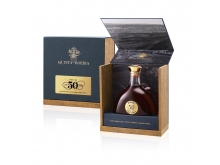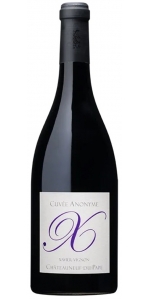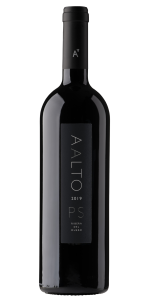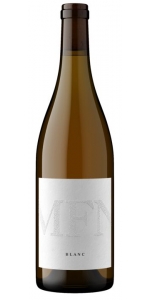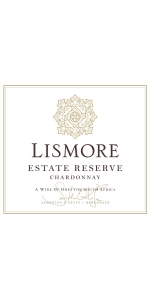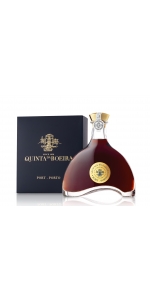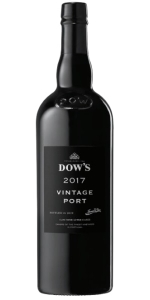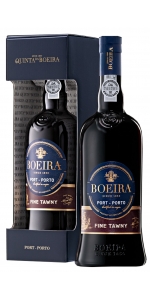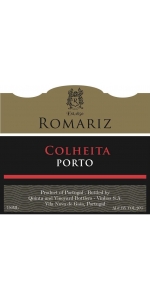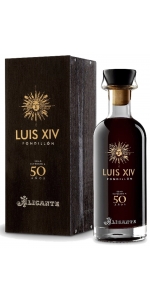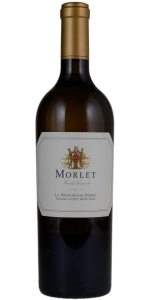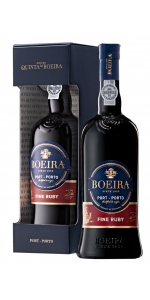Boeira Tawny 50 Year Port
2 bottles with free shipping for: $790.00
3 bottles with free shipping for: $1,170.00
| BUY MORE! SAVE MORE! | ||||||||||||||||||||
|
| Country: | Portugal |
| Region: | Douro |
| Winery: | Boeira |
| Grape Type: | Port Blend |
| Vintage: | NV |
| Bottle Size: | 750 ml |
Boeira Tawny 50 Year Port is produced from Touriga Nacional, Touriga Franca, Tinta Roriz, Tinta Barroca and Tinto Cao.
Brownish color with strong coppery reflections. Toasted almonds and dried fruit stand out on the nose, with a delicate sweetness. Intense flavors on the plate, but a refinement and elegance that reflects its level of ageing. A very long evolving finish.
Boeira 50 Years Old Port is excellent as a digestive.
pH : 3.57TA : 9.48 g/L
RS : 152g/L
Then, it is aged for 50 years in 550 liter French oak barrels.
Traditional Porto winemaking with skin contact maceration and short alcoholic fermentation in stainless steel tanks followed by fortification.
Quinta da Boeira was built by an emigrant named Manuel da Rocha Romariz, who returned from Brazil in the early 19th century. Knowing the Brazilian market, he registered as an exporter of Port Wine in 1850, using two trade names for the labels: ROMARIZ and BOEIRA.
These brands quickly won the consideration and confidence of consumers and distributors due to their quality, expanding to several markets, among which Portuguese, English, French and Brazilian stood out, among others.
In 1966, the property was acquired by an English family, the warehouses by a textile company and the wines were sold to a Port Wine exporting company.
In 1999 the property was put up for sale with the main interest of a contractor who intended to build luxury homes in a closed condominium.
Father João de Freitas Ferreira, director of a school in Vila Nova de Gaia, warned of the situation of the eminent possibility that the 3 hectares of the property could be transformed into massive construction, with the consequent destruction of its centennial grove.
Concerned and sensitized to the cause, Father João de Freitas Ferreira, integrating a group of ten friends, decided to acquire the property, thus protecting the centenary trees and the palace of the early 19th century.
For the acquisition of the property, a financial study was carried out with the division of investments into five phases:
FIRST PHASE
The transformation of stables and greenhouses into a multi-purpose hall with auditorium and the restoration of all paths in the gardens represented the initial phase of the project which, from the beginning, intended to transform Quinta da Boeira into a visiting room in the north of the country and, more specifically , in Vila Nova de Gaia.
SECOND PHASE
The recovery of the mansion, which was in an advanced state of deterioration, began, transforming it into offices and a luxury restaurant with a capacity for about 80 people seated.
THIRD PHASE
In order to attract tourists to the high elevation of the city of Vila Nova de Gaia, the largest bottle in the world was built, measuring 32 meters in length and 10 in diameter, thus allowing the creation of a tasting room and exhibition room to promote Portuguese wines, culture and gastronomy. It was also possible to adapt the room for the transmission of films in 3D, letting tourists know the different wine regions of Portugal.
FOURTH PHASE
With the objective of financially consolidating the entire project, Quinta da Boeira registered at the Instituto dos Vinhos do Douro e do Porto (IVDP) in 2017, thus returning to the genesis of Quinta da Boeira in 1850, as an exporter of Vinhos do Porto, under the BOEIRA brand.
FIFTH PHASE
The project, in its fifth and final phase, concluded with the construction of a 5-star hotel, with 119 rooms and 5 suites, whose construction was based on the green system. The most up-to-date environmental techniques were implemented, such as the use of groundwater to supply sanitary tanks and automatic irrigation of about 3 hectares of the property, with photovoltaic and solar energy also being used, which allowed for remarkable savings and drastic reduction in carbon emissions, transforming it into an ECO hotel.
The most recent challenge was the acquisition of the C. da Silva family home, a name also linked to the export of Port Wines, designed in the 19th century by the architect Teixeira Lopes. Quinta da Boeira is a reference in wines of superior quality, namely in Port Wine, duly certified by the Institute of Douro and Port Wines and proudly marked with the knight seal on the neck, according to the guidelines that the Observatório do Port wine advocates for the defense of the Porto Denomination of Origin.
Each Quinta da Boeira wine is a unique experience, in which Wine and Art are intimately linked, having their maximum exponent in unique bottles and which are distinguished by their shape and aesthetics, such as Diamond or Decanter.
Xavier Vignon Chateauneuf-du-Pape Rouge Cuvee Anonyme 2019 is made from 60% Grenache, 15% Mourvedre, 10% Syrah and the rest is "field blend" with the following grapes : grenache, vaccarese, counoise, mourvèdre, terret noir and muscardin.
One of Xavier Vignon's first almost anonymous blends only in MAGNUMS !
The grapes come from "collection vines", where many grape varieties are planted together, making it difficult to identify the exact share of each variety: grenache, vaccarese, counoise, mourvèdre, terret noir and muscardin.
Partially destemmed and vinified in a mix of demi-muids and tank, it offers a beautifully pure, vibrant bouquet of black raspberries, white and black pepper, candied orange, and violets. Complex, layered, and nuanced, this beauty is medium to full-bodied, has a seamless texture, and a great finish. It has both elegance and richness, and will keep for 15+ years.
Pairing: Duck in sauce with olives. Ravioli with porcini mushrooms, cream of parsnip and bacon crisps. Partridge leg confit with olive oil.
Review:
"The flagship from Xavier is the 2019 Châteauneuf Du Pape Cuvee Anonyme, and in 2019 it’s 60% Grenache, 15% Mourvèdre, 10% Syrah, and the balance a mix of permitted varieties. Partially destemmed and brought up in a mix of demi-muids and tank, it offers a beautifully pure, vibrant bouquet of black raspberries, white and black pepper, candied orange, and violets. Complex, layered, and nuanced, this beauty is medium to full-bodied, has a seamless texture, and a great finish. It has both elegance and richness, and will keep for 15+ years."
- Jeb Dunnuck (October 2020), 95-97 pt
Aalto P.S. Pagos Seleccionados Tinto is made from 100 percent Tempranillo.
Climatic conditions
The farming year began with a mild autumn and little precipitation. A very dry winter started with -9ºC reaching at the end higher temperatures than normal for that time of the year. Spring and summer characterized by little rain, only some rain showers in July and late August avoided the hydric stress of the vines. The vegetative cycle of the vine developed with big variations of temperatures, alternating warm and atypical low temperatures of 4ºC for mid-June. The ripening of the grapes happened under very good conditions and the harvest started on 24th September 2019.
Grape origin
100% Tinto Fino (Tempranillo) primarily from very old vines – 60 to 90 years old – from selected plots in La Horra and La Aguilera. The harvest was done by hand, in small boxes of 15 kilos that are thoroughly inspected, bunch by bunch, on the selection table.
Tasting notes
Average oak ageing
Aged for 21 months in new French oak barrels.
Review:
Color: dark cherry, Aroma: toasty, spicy, fine cocoa, black fruit, Mouth: tasty, toasty, fine bitterness, ripe tannins
Guia Penin 94 Points
A deep and rich hue of golden straw gives the first clue that this is a serious Chardonnay. Aromas of pear, green apple, and lime peel jump out of the glass followed by more nuanced fragrances of orange blossom, ginger root, and brioche. The sensation on the palate casually demonstrates both broad depth and laser like focus. An assertive core of acid and saline minerality rests completely ensconced in rich flavors of pie crust, clotted cream, and burnt caramel. Drink now for fresh vibrance, or in ten years for wild complexity. This wine is a perfect white to be enjoyed year-round.
Review:
The 2021 MFN Blanc Chardonnay is very ripe in style with scents of banana chip, apple pie, jasmine, allspice and brown sugar. The full-bodied palate is packed with ripe, spicy fruits and plenty of refreshing acidity, and it finishes long with a satiny, mouth-coating texture. It's an old-school style reminiscent of Napa that fans of ripe, oaked Chardonnays will enjoy.
-Robert Parker 97 Points
Lismore Chardonnay Reserve made from 100 percent Chardonnay.
A careful selection of the best of the vintage that exemplifies the extraordinary terroir of Lismore. This Reserve Chardonnay shows intense citrus, stone fruit, jasmine and walnut layered with honey and vanilla carried by a distinct minerality and crisp acidity with a lingering citrus finish.
Wine Made in the Soil
The vineyards are planted in decomposed shale over clay at 300 meters in the foothills of the Sonderend Mountain Range. A low mean February temperature lends to an extended ripening period that can put harvest 3-4 weeks later than traditional wine growing regions in South Africa. The intense citrus notes and the lingering finish are consistent trademarks of Lismore's specific terroir. The restrained minerality of the Chardonnay is a clear indication of the cool climate in which it is grown.
Wine of Origin "Greyton" has been designated by SAWIS recognizing the special terroir of this region.
Delightful with warm curries which lift the aromatics or a traditional pairing of smoked salmon highlighting the fresh acidity.
Review:
100% Chardonnay matured in Burgundian oak (33% new) for 11 months. This Reserve Chardonnay shows intense citrus, stone fruit, jasmine and walnut layered with honey and vanilla carried by a distinct minerality and crisp acidity with a lingering citrus finish.
-Karen McNeil 95 points
It has a brownish red color. Intense and complex, aged for many years in French oak. It has an elegant cigar leaf aroma. Dense and round in the mouth with dried fruit, honey and notes of crystallized fruit. A velvety and persistent finish.
RS: 114g/Liter
TA: 3.7g/Liter
No irrigation, Harvest by hand, Port wine traditional method: (Fermentation, with skin maceration, takes place a a controlled temperature and is interrupted by the addition of grape spirits).
Aged in 550 Liters French Oak barrels with an average age of 40 years.
Slightly filtered before bottling.
Pairings: Digestive: Dried fruits, caramel sweets and conventual sweets (portugueuse pastries)
The 2017 was a very different year to 2016 in terms of the viticultural conditions and it was interesting to watch the progression of the wine and scrutinize its quality as it developed over its first two winters. Whereas 2016 had a very mild winter and exceptionally hot summer, this was compensated by abundant winter and spring rainfall. Conversely, 2017 was warm and drythroughout, although summer temperatures were closer to average, whichproved to be a very significant factor allowing for complete, balancedripening.
It is rare to see such tremendous depth and intensity in color as this winedisplays. The freshness of the floral aromas is very attractive with adominance of rockrose, a flower that grows wild around the hills of Senhorada Ribeira. On the palate, it is exceptionally full-bodied, rich andpowerful with black fruit coming to the fore. Gorgeous, ripe fruit isbalanced by the fine tannin structure. On the finish, it is typically Dow,austere and somewhat drier than many other ports. The intense fruit flavors linger long on the palate.
Dow’s Vintage Ports are only produced in years of exceptional quality and represent only a very small part of the total company’s production in that year. On average only two or three times every ten years are the weather conditions sufficiently good to allow for the making of Dow’s Vintage Port.
Throughout the 19th and 20th centuries, Dow’s Vintage Ports have been landmark wines in virtually every great year, consistently setting the standards amongst all Port houses. Vintage Ports such as the remarkable Dow 1896, the 1927, 1945, 1955, 1963, 1966, 1970, 1980 and the Dow 1994 are all legends in the history of this great wine. These Ports are still magnificent today, even when 50 or over 100 years old. Few wines can claim this quality and this pedigree.
Dow's Vintage Ports are drawn from the companies' finest vineyards; Quinta do Bomfim and Quinta de Senhora da Ribeira. Each property contributes to the Dow’s unique and distinctive style. When young, Dow’s Vintage Ports are purple-black, austere, complex and intensely concentrated, full-bodied and balanced with very fine peppery tannins.
Over the centuries, the Dow winemakers have evolved a style that suits the house’s key vineyards; fermentations are a little longer, resulting in a drier Port Wine that has become the hallmark of Dow’s. Abundant fruit flavours with hints of ripe blackberries, give elegance and poise to Dow’s. The nose is deep and powerful with strong overtones of violets when young, these mature into fine cinnamon and rose-tea aromas with age. The very high percentage of Touriga Franca and Touriga Nacional planted on the vineyards result in the powerful structure and aging potential of Dow’s Vintage Ports
Dow’s Ports avoid an over-rich style and requires a very high degree of skill in wine making and great experience in selecting the finest wines of each year and each vineyard. These wines are aged in seasoned oak casks for some 18 months and are bottled without any filtration or fining whatsoever.
Dow Vintage Ports can be enjoyed when vibrant and young or they can be allowed to age for many years in bottle into a soft and delicate wine of velvet-like elegance.
In the 1920’s, the celebrated Oxford Professor George Saintsbury underlined Dow’s outstanding reputation when he wrote in his famous ‘Notes on a Cellarbook’ (first published in 1920), “There is no shipper’s wine that I have found better than the best of Dow’s 1878 and 1890 especially.”
James Suckling, one of today’s leading authorities on Vintage Port was equally impressed by another legendary wine - the Dow’s 1896 - “The ancient {1896} Port still had an amazing ruby colour with a garnet edge, and it smelled of raisins, black pepper and berries. It was full-bodied, with masses of fruit intertwined with layers of velvety tannins. It was superb.” In 1998, when this wine was 102 years old, he awarded this Port an exceptional 98 points.
Review:
Based on fruit from the predominantly south-facing Quinta do Bomfim in the Cima Corgo and Quinta Senhora da Ribeira in the Douro Superior, with Touriga Nacional and Touriga Franca making up 80% of the blend. This is opaque and closed in but powerfully ripe with underlying pure berry fruit. It's seemingly quite introverted compared to some of its peers at this stage, but it's still full, rich and opulent on the palate. It also shows the latent power of the vintage, made as it is in a slightly drier style (3.4 Baumé), with lovely minty fruit and full, ripe sinewy tannins all the way through the finish. Long and lithe, and very fine.
-Decanter 97 Points
A dense, thickly textured version, dripping with warm salted licorice, tar and açaí paste notes, while plum and blueberry pâte de fruit, chai spice and chocolate elements fill in behind. Lots of brambly grip flows underneath. Shows a very sappy feel on the finish. Best from 2035 through 2055. 5,250 cases made, 1,092 cases imported
-Wine Spectator 96 Points
This is a dry while also floral wine, perfumed and enticing with its juicy acidity. At the same time, the structure is very present, showing power and dark black fruits. The balance is coming together with the rich fruits and tannins melding into one. Drink from 2028. ROGER VOSS
-Wine Enthusiast 96 Points
Deep dark ruby garnet, opaque core, violet reflections, delicate brightening of the edges. Black wildberry jam underlaid with delicate herbs and spices, tobacco nuances, hints of blueberry jam and elderberries, schisty notes. Powerful, full-bodied, sweetness present, carrying tannins, dark nougat in the finish, very good length, an imperious style, built for a long life.
Falstaff 98 Points
It has a brownish red color. Intense and complex, aged for many years in French oak. It has an elegant cigar leaf aroma. Dense and round in the mouth with dried fruit, honey and notes of crystallized fruit. A velvety and persistent finish.
RS: 114g/Liter
TA: 3.7g/Liter
No irrigation, Harvest by hand, Port wine traditional method: (Fermentation, with skin maceration, takes place a a controlled temperature and is interrupted by the addition of grape spirits).
Aged in 550 Liters French Oak barrels with an average age of 40 years.
Slightly filtered before bottling.
Pairings: Digestive: Dried fruits, caramel sweets and conventual sweets (portugueuse pastries)
Golden red color.
On the nose, aromas of red fruits with the complexity of dried fruits.
In the mouth, its freshness is combined with a natural sweetness and a slight touch of wood.
RS: 134 g/Liter
TA: 3.3 g/Liter
pH: 3.6
Made from Touriga Nacional, Touriga Francesa, Tinta Barroca, Tinta Roriz, Tinto Cão, Tinta Amarela
The color is beginning to denote the age, showing a certain similarity to coffee and waxed wood. The aroma combines quince-jam, delicate orange blossom and a touch of vanilla. Delicious smooth butterscotch and dried fruit flavors.
A Romariz Colheita brings together the finest wines from good extensive stocks to express the individual richness and flavours of the particular year enhanced by the nutty characteristics that come with the Tawny ageing process.
Pairs with nut based desserts, pecan pie and apple strudel.
Luis XIV Fondillon Oro 50 years NV is made from 100 percent 100% Monastrell (Mourvedre). Only 24 9 liter cases produced.
The wine is produced in the village of Cañada, in the subarea of Alto Vinalopó in the province of Alicante. Made from 100% Monastrell planted on traditional dry land as bush vines, at 550-580 meters above sea leval and enjoying a Mediterranean climate with great marine influence due to the easterly winds.
Fondillon 50 years is mahogany in color with orange tile rim, medium layer and great density. On the nose, it has a very deep aroma of old wood, black tea and carob. In the mouth, it has a sweet entry balanced by a rich high acidity. Its aromas are long, almost eternal and very intense. It tastes like old mahogany, a very old barrel and bygone times.
Bottled in December 2019.
AGEING:
CASK NAME: Saboners.
AGEING: Aged more than 50 years (single barrel).
TYPE OF WOOD: 19th-century American oak barrels
CASK SIZE: 70 “cántaros valencianos” (805 litros).
ANALYSIS:
GLUCOSE AND FRUCTOSE: 34 gr/litre.
VOLATILE ACIDITY: 1.35 gr/l.
ALCOHOL: 16.2º (NO ADDED ALCOHOL).
FREE SULFITES: less than 10 mg/litre.
TOTAL SULFITES: 76 mg/litre.
Review:
Dark mahogany color, candied fruit aromas, fruit liqueur notes, spicy, varnish, acetaldehyde, bakery, complex. Fine solera notes, bitter flavors."
- Penin 2022, 99 pts
"The NV Fondillón Luis XIV has the subtitle Edad Superior a 50 años (over 50 years old), and it's a dark mahogany, bottled from a single barrel that has the specific profile of a very old wine greatly concentrated by age, which tends to make it similar to other very old and concentrated wines, be it a Mediterranean rancio or a very old Moscatel. It has notes of bitter chocolate, coconut and iodine, carob beans (algarroba) and some bittersweet sensations. It's dense and concentrated, and the palate is pungent, with very intense flavors and a bitter twist in the finish. This has 16.3% alcohol, 6.45 grams of acidity and 34 grams of sugar, but it comes through as very dry. The wine is long and extraordinary, but it just doesn't have any Fondillón character after decades of concentration by evaporation. The price is ludicrous. Only 435 half-liter bottles were filled in December 2019. - Luis GUTIERREZ
- Wine Advocate (September 2020), 95 pts
"Fondillón is an extraordinary treasure of Alicante, a rare product, made from late harvest, non-botrytised grapes, unfortified, but with a final alcohol of no less than 16%. Intense, aged, but not sweet (deliciously not more than 45g/l). Fab with cheese or dark chocolate. The wines have to be a minimum of 10 years; this release is more than 25 years. The project is a revival by David Carbonell of Vins del Comtat and two local families. Very limited quantities. - Sarah Jane Evans MW"
- Decanter (December 2021, My top 10 Spanish fine wines of 2021), 95 pts
Morlet Family Vineyards La Proportion Doree is made from made from Sémillon (65%), Sauvignon Blanc (33%) and Muscadelle (2%).
A harmonious blend of the three classic white Bordeaux varietals grown in the Golden State’s Sonoma County, this unique cuvée was handcrafted using classical winemaking techniques inspired from Pessac-Léognan. As in architectural arts, it is ‘The Golden Ratio’ or ‘La Proportion Dorée.’ Bright yellow. Intense bouquet of candied lemon, muscat, and honeysuckle flavors intermixed with sweet notes of ripened apricot and fresh quince. Full-bodied, seamless, refined and complex.
Review:
Luc Morlet has 100 Muscadelle vines, planted in 1953, which he co-ferments with the Sauvignon Blanc to produce this Semillon-based wine. Composed of 69% Semillon, 30% Sauvignon Blanc, and 1% Muscadelle, the 2020 Proportion Doree is a tad closed - it was only bottled in March this year. It soon reveals notes of ripe peaches, gooseberries, and white currants, with hints of white pepper, coriander seed, and oyster shell. Full-bodied, the palate is wonderfully viscous and racy with intense citrus and apple flavors, finishing long and chalky. 800 cases were made.
-Wine Independent 98 Points
Medium intensity ruby color.
Nose dominated by red fruits.
In the mouth, elegant structure with solid but well integrated tannins. Rich and fruity finish.
RS: 104 g/Liter
TA: 3.8 g/Liter
pH 3.73
- back
Kinsella Estates Jersey Boys Cabernet Sauvignon is made from 100 percent Cabernet Sauvignon.
Winemaker: Thomas Rivers Brown
Pure 100% cabernet Sauvignon, this vineyard continually astonishes. Loads of loamy soil notes followed by blue and black fruits give this cabernet massive depth and beautiful integrated tannins. Milk chocolate, crème de cassis and tobacco give this massive wine the depth you come to expect with Napa cabs, but it is all Sonoma County, all from our magnificent little private valley which sees sun all day! We buy no fruit; we sell no fruit.
Jersey Boys Vineyard (Kevin Kinsella is the largest individual investor in the hit Broadway show "Jersey Boys")
Jersey Boys is a six-acre vineyard that was replanted in 2008 with four different clones of Cabernet Sauvignon, handpicked by winemaker Thomas Rivers Brown.
Wow…just Wow!! This wine has it all. Not as “big” as past vintages this wine is gangbusters right out of the gate. Ripe blackberry, juicy and rich with a wonderful chocolate core. Has a dusky quality that we have seen in this vineyard in the past that tricks your brain into thinking the wine is older than it is. It’s pure. It’s rich. It’s delicious! Winemaker Thomas Rivers Brown
Any vegetable or meat in the grill. Delicious with Chocolate as well.
Cabrieres Chateauneuf du Pape Rouge L'Esprit is made from 50% Grenache, 15% Syrah, 15% Mourvèdre, 10% Cinsault and 10% remaining: Muscardin, Counoise, Picpoul, Terret noir, Vaccarèse, Clairette, Bourboulenc, Roussanne, Picardan.
The vineyard is situated on the high tablelands, which are characteristic of the northern area of Châteauneuf-du-Pape. The terrain consists mainly of alpine diluvium and chalky Miocenian soil, with large flint pebbles covering the surface. These pebbles conserve the heat of the day during the night, thus avoiding too much evaporation.
85-year-old vines. Aged 12 months in French oak. Intense ruby color, with a dominant nose of black fruits (blackcurrant and blackberry) evolving into smoke and grilled notes. Robust tannins on the palate with a long finish.
Pair with choice red meat, prime rib and game, or try with strong cheeses and chocolate dessert.

